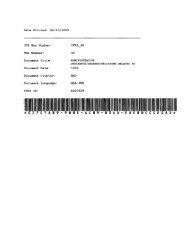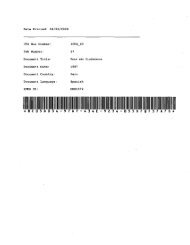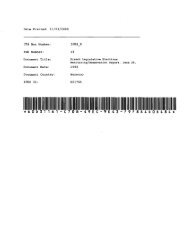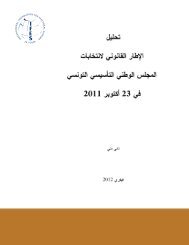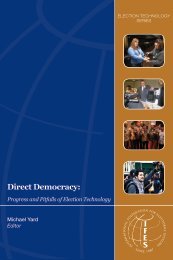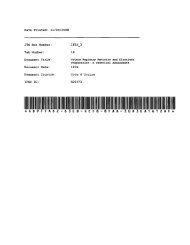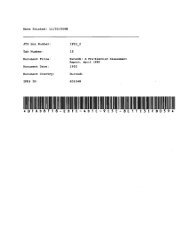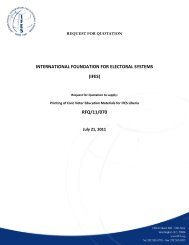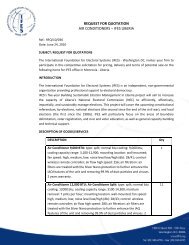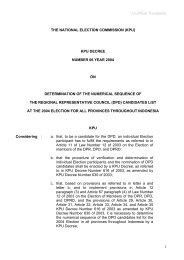Electronic Voting & Counting Technologies - IFES
Electronic Voting & Counting Technologies - IFES
Electronic Voting & Counting Technologies - IFES
- No tags were found...
You also want an ePaper? Increase the reach of your titles
YUMPU automatically turns print PDFs into web optimized ePapers that Google loves.
INTRODUCTIONINTERNATIONAL ELECTORAL STANDARDS• Increase in Turnout — <strong>Electronic</strong> votingand counting technologies may increaseturnout if these technologies helpimprove trust in the electoral process;if the technology makes people moreinterested in participating or increasesaccess for certain communities. 5“<strong>Electronic</strong> voting andcounting technologiesmay increase turnout ifthese technologies helpimprove trust in the electoralprocess.”• Elimination of Invalid/Incorrectly CastBallots — In some countries significantnumbers of ballots are deemed invalidand not counted. Those voters aredisenfranchised. Where ballots are castand recorded electronically, the electronicvoting software can be configuredto ensure only valid ballots are cast(although blank ballots may still beallowed). Likewise where paper ballotsare inserted into an electronic ballot box,the validity and choices of the voter canbe displayed, allowing voters to changetheir ballot if a mistake was made.• Speed of <strong>Counting</strong> — An importantadvantage of using electronic votingtechnology, which directly recordvotes electronically, is that results areimmediately available after polls close,without a lengthy counting process.5 For example, geographically remote communities,people with disabilities and overseas voters.Even when paper ballots are used,but electronically counted, the resultsare normally available a lot faster thanmanual counting.• Standard Adjudication of Ballots —<strong>Counting</strong> paper ballots electronicallyensures that the same kind of ballotmarking is adjudicated in the samemanner across all polling stations. Thisensures consistency on which ballots arecounted and which are determined tobe invalid. This is often not the case withmanual counting of ballots.• Accurate Tabulation of Results — Whenresults are electronically recorded andtransmitted to the election managementbody (EMB) for tabulation, the possibilityof data entry errors during resultstabulation is greatly diminished.• Impartiality — <strong>Electronic</strong> voting andcounting technologies follow predefinedrules and are independent from humaninfluence and impartial.• Fraud Prevention — <strong>Electronic</strong> votingand counting technologies can mitigatesome fraud in polling stations. Forexample, some electronic voting andcounting technologies only allow votesto be cast at a certain speed, thusmitigating ‘ballot stuffing.’ Similarly,electronic counting of ballots mitigatesfraud during the counting process.<strong>Electronic</strong> voting and countingtechnologies cannot, however, eliminateall aspects of electoral fraud.6<strong>Electronic</strong> <strong>Voting</strong> & <strong>Counting</strong> <strong>Technologies</strong>: A Guide to Conducting Feasibility Studies



